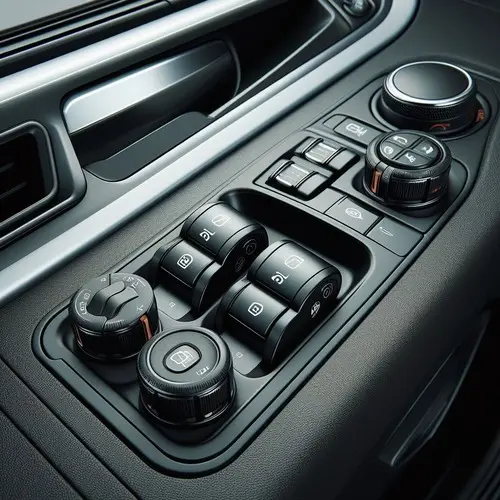Safety is paramount when it comes to family road trips or even just the daily school run. Every parent wants peace of mind knowing their loved ones are protected while on the road. That’s where safety features in vehicles come into play. This comprehensive guide will explore the critical child safety features families should look for when purchasing a vehicle.

Why Does Safety Matter
For families, safety isn’t just a preference; it’s a necessity. Whether protecting precious cargo during a sudden stop or ensuring everyone stays secure during a collision, the proper safety features in cars can make all the difference.
While many associate car safety with seat belts and airbags, cars have functional safety features within the vehicle’s interior. These safety features in cars are designed to enhance the overall safety and convenience for families on the move.
Focus on Non-mechanical Safety Features in Vehicles
In this guide, we’ll shift our focus from the car’s mechanical components to the interior features directly impacting family safety. From child-friendly controls to advanced driver assistance systems, we’ll explore the innovative technologies that make modern vehicles safer for families.
Now, let’s dive into the specifics of these safety features, ensuring you’re equipped with the knowledge to make informed decisions when selecting your next family car.
Child Safety Features
Child safety features are essential for keeping your little ones safe on the road. Let’s explore some key features designed to protect your most precious passengers.

Child Safety Locks and Window Controls
Child safety locks and window controls are invaluable features that prevent curious little hands from accidentally opening doors or windows while the vehicle is in motion. These controls, usually located on the driver’s door panel, allow parents to deactivate rear window operation and door opening mechanisms, ensuring children remain safely inside the vehicle.
Rear Seat Reminders for Child Passengers
In today’s busy world, it’s too easy for parents to become distracted, especially when juggling multiple responsibilities. Rear seat reminders are innovative safety features that help prevent the tragic scenario of leaving a child unattended in the back seat.
These systems typically use sensors to detect when a rear door is opened and closed before or during a trip. If the rear door is opened and closed before the journey begins, the system reminds the driver to check the back seat before exiting the vehicle.
Another Interesting Safety Feature in Cars is the Integrated Child Booster Seat
Integrated child booster seats offer a convenient and safe solution for families with younger children. These built-in seats provide optimal positioning and restraint for children who have outgrown traditional car seats but still require booster seats for proper belt fit. Integrated booster seats ensure correct installation and eliminate the need to transfer bulky seats between vehicles, making family travel more convenient and secure.
With these child safety features in place, you can drive with confidence, knowing your little ones are protected every step of the way. Next, let’s explore the advanced driver assistance systems that add a layer of safety for families on the road.
Driver Assistance Systems
In an ever-evolving automotive landscape, driver assistance systems play a crucial role in enhancing safety on the road. Let’s explore advanced technologies designed to assist drivers and mitigate potential risks.
Blind Spot Monitoring
Blind spot monitoring systems utilize sensors to detect vehicles or obstacles in the driver’s blind spots, typically located to the side and rear of the car. When a vehicle enters the blind spot, the system alerts the driver through visual or audible cues, reducing the likelihood of accidents during lane changes or maneuvers.
Lane Departure Warning Systems
Lane departure warning systems help prevent unintended lane departures by monitoring the vehicle’s position within lane markings. Where there is unintended drifting via vibrations, sounds, or dashboard visuals, the system warns the driver. This feature particularly benefits tired or distracted drivers, reducing the risk of side-swipe collisions or road departures.
Rearview Cameras and Parking Sensors
cameras and parking sensors provide valuable assistance when maneuvering in tight spaces or reversing out of parking spots. They provide a clear rear view, eliminating blind spots and helping avoid obstacles or pedestrians.
Parking sensors complement the camera by detecting objects near the car and alerting the driver through audible beeps or visual indicators, ensuring safe and precise parking maneuvers.
Incorporating these driver assistance systems into your family vehicle gives you an extra set of eyes on the road, enhancing overall safety and confidence behind the wheel. Up next, let’s explore passive safety features designed to protect occupants in the event of a collision.
Passive Safety Features in Vehicles
While proactive measures like driver assistance systems are essential, passive safety features are vital in protecting occupants during a collision. Let’s explore some of the critical passive safety features designed to mitigate the impact of crashes and minimize injuries.
Side Curtain Airbags
Side curtain airbags are supplemental restraint systems deployed from the roof lining above the windows during a side-impact collision or rollover. These airbags provide additional protection for occupants’ heads and torsos, helping reduce the risk of head injuries and ejection from the vehicle.
Side curtain airbags are particularly beneficial for passengers seated in the outboard positions, offering enhanced safety during a crash.
Impact-Absorbing Materials in the Interior
Modern vehicles are equipped with impact-absorbing materials strategically placed throughout the interior to dissipate crash forces and reduce the severity of injuries.
These materials, such as energy-absorbing foam and reinforced structural components, help absorb and distribute impact energy away from occupants, minimizing the risk of injury during a collision.
Head Restraints and Adjustable Seatbelts
Head restraints and adjustable seatbelts are essential passive safety features that help prevent whiplash and reduce the risk of neck and spinal injuries in rear-end collisions. Properly positioned head restraints support the head and neck, while adjustable seatbelts allow occupants to customize the fit for optimal protection.
Together, these features keep occupants securely restrained and supported in their seats during a crash, reducing the likelihood of serious injuries.
By incorporating these passive safety features into your family vehicle, you can rest assured knowing that you’re providing extra protection for your loved ones in the event of a collision. Next, let’s explore the importance of ergonomic design for family safety within the vehicle.

Ergonomic Design for Family Safety
In addition to active and passive safety features, the ergonomic design of a vehicle plays a crucial role in ensuring the safety and comfort of all occupants, especially families. Let’s explore some vital ergonomic features contributing to a safer and more convenient driving experience.
Easy Access Controls for Door and Window Operation
Conveniently located and user-friendly door and window operation controls are essential for families, especially when traveling with young children. Easily accessible buttons and switches allow drivers to open and close windows or doors with minimal effort, reducing distractions and ensuring quick emergency response times.
Visibility-enhancing features such as Adjustable Seating Positions
Optimal visibility is essential for safe driving, particularly when navigating busy streets or crowded parking lots. Adjustable seating positions enable drivers to find the most comfortable and ergonomic driving position while ensuring an unobstructed view of the road ahead.
Additionally, features such as adjustable steering columns and mirrors enhance visibility and minimize blind spots, allowing drivers always to maintain awareness of their surroundings.
Anti-Pinch Technology for Power Windows and Sunroofs
Power windows and sunroofs add convenience and comfort to the driving experience but can pose a safety risk, especially for young children. Anti-pinch technology detects obstructions, such as fingers or objects, in the window or sunroof’s path and automatically reverses the closing mechanism to prevent injury or damage. This feature provides peace of mind for parents, knowing their children are protected from accidental injuries while operating the windows or sunroof.
Manufacturers prioritize safety and convenience by incorporating ergonomic design features into family vehicles, creating a more enjoyable and secure driving experience for all occupants. Next, let’s explore the importance of emergency response features for families on the road.
6. Emergency Response Features
In an emergency or collision, having the proper emergency response features can make all the difference in ensuring the safety and well-being of everyone in the vehicle. Let’s explore key features designed to assist and protect during critical situations.
Automatic Collision Notification Systems
Automatic collision notification systems are advanced safety features that alert emergency services during a collision. Using sensors to detect the severity of the impact, these systems can quickly dispatch help to the scene, even if the driver cannot call for assistance.
This rapid response can significantly reduce emergency response times and improve the chances of survival for occupants involved in a severe crash.
Emergency Trunk Release Mechanisms
Trapped inside the trunk of a vehicle is a terrifying scenario that no one wants to experience, especially for children or individuals with limited mobility. Emergency trunk release mechanisms provide a simple and effective means of escape in such situations.
These mechanisms allow occupants to quickly open the trunk from the inside, providing a vital lifeline in emergencies such as kidnappings, carjacking, or accidental lock-ins.
Post-Collision Safety Features such as Automatic Fuel Shut-Off
In the aftermath of a collision, fire or fuel leakage risk can pose additional hazards to occupants and first responders. Post-collision safety features, such as automatic fuel shut-off systems, help mitigate these risks by automatically cutting off fuel flow to the engine upon impact. This prevents fuel from leaking and reduces the likelihood of fire, enhancing the vehicle’s and its occupants’ overall safety.
By equipping vehicles with these emergency response features, manufacturers prioritize the safety and well-being of families on the road, providing peace of mind and reassurance in times of crisis. Now, let’s explore maintenance and care considerations to ensure that safety features remain in optimal condition over time.
7. Maintenance and Care Considerations
Ensuring the continued effectiveness of safety features in your family vehicle requires regular maintenance and care. Let’s explore some essential considerations to keep your safety systems in optimal condition over time.
Regular Inspection and Maintenance of Safety Features
Like other components of your vehicle, safety features require regular inspection and maintenance to ensure they function as intended. Schedule routine checks of your vehicle’s safety systems, including airbags, seat belts, and electronic stability control. Look for signs of wear or damage and promptly address any issues to maintain peak performance.
Importance of Keeping Safety Systems Up-to-Date with Software Updates
As technology evolves, manufacturers may release software updates to enhance the performance and functionality of safety systems in your vehicle. Stay informed about any updates or recalls affecting your vehicle’s safety features, and schedule appointments with your dealership or mechanic to ensure that all software is up-to-date. This proactive approach helps address potential vulnerabilities and ensures that your safety systems remain effective.
Tips for Ensuring Optimal Performance of Safety Features Over Time
To maximize the lifespan and effectiveness of your vehicle’s safety features, consider the following tips:
By prioritizing regular maintenance and care of your vehicle’s safety features, you can help ensure the continued protection of your loved ones on the road. Now, let’s explore shopping tips for families to consider when selecting an affordable vehicle with the best safety features.
Shopping for a Family car: What to look for.
Choosing the right vehicle for your family involves careful consideration of safety features to ensure the utmost protection for your loved ones. Here are some essential shopping tips to guide you through the car-buying process:

Prioritizing Safety Features During the Car-Buying Process
When evaluating potential vehicles, prioritize safety features as a top consideration. Look for models that offer comprehensive safety suites, including advanced driver assistance systems, passive safety features, and ergonomic design elements.
Consider your family’s specific needs and preferences, such as the number of passengers and typical driving conditions, to determine which safety features are most important for your situation.
Questions to Ask Dealerships About Available Safety Features
Before making a purchase, ask dealerships about the safety features available in their vehicles. Inquire about specific technologies and systems, such as collision avoidance systems, emergency response features, and child safety enhancements.
Request demonstrations or explanations of how these features work and their potential benefits for your family’s safety. Additionally, please get in touch with us if you’re considering any optional safety packages or upgrades for the vehicle.
Budget Considerations and Cost-Effective Safety Options
While safety is paramount, it’s also essential to consider your budget when selecting a vehicle. Evaluate the cost-effectiveness of different safety features and prioritize those that offer the most significant impact on safety for your investment.
Remember that some safety features may come standard on specific models, while others may be optional upgrades. Balance your safety priorities with budget constraints to find the best value for your family’s needs.
By prioritizing safety features, asking informed questions, and considering budget constraints, you can confidently select a vehicle that prioritizes the safety and well-being of your family. Now, let’s conclude with a recap of the importance of safety features in family vehicles.
As a final note
As families embark on their journey to find the perfect vehicle, the importance of prioritizing safety features cannot be overstated. Here’s a reminder of why safety should be your top consideration when selecting a family car and some final thoughts on creating a safe and secure driving environment for your loved ones.
Safety is critical when it comes to family vehicles. From child safety locks to advanced driver assistance systems, safety features play a crucial role in protecting your loved ones on the road. By prioritizing safety during car-buying, you can ensure your family travels in a vehicle equipped to handle the unexpected and keep everyone secure. As you navigate the car-buying process, don’t hesitate to ask questions and seek information about available safety features.
Take the time to research different models, compare safety ratings, and test-drive vehicles to experience their safety features firsthand. Making informed decisions about vehicle safety empowers you to choose a car that meets your family’s needs and provides peace of mind on every journey.
